Ultrafiltration Process in Disinfection and Advanced Treatment of Tertiary Treated Wastewater
Abstract
1. Introduction
2. Materials and Methods
2.1. Study Area
2.2. Experimental Setup
2.3. Wastewater Sampling
2.4. Physico-Chemical Analysis
2.5. Microbiological Analysis
2.5.1. Cultivation Methods
2.5.2. Microscopic Methods
2.6. Statistical Analysis
3. Results and Discussion
3.1. Physico-Chemical Analysis
3.2. Reduction of Indicator Bacteria (Fecal Coliforms, including E.coli–FC and Fecal Enteroccoci—FE)
3.3. Reduction of Single Prokaryotic Cells Determined by Microscopic Method
3.4. Reduction of Virus Particles (VP)
4. Conclusions
Author Contributions
Funding
Institutional Review Board Statement
Informed Consent Statement
Data Availability Statement
Acknowledgments
Conflicts of Interest
References
- Stampi, S.; De Luca, G.; Zanetti, F. Evaluation of the efficiency of peracetic acid in the disinfection of sewage effluents. J. Appl. Microbiol. 2001, 91, 833–838. [Google Scholar] [CrossRef]
- Koivunen, J.; Heinonen-Tanski, H. Peracetic acid (PAA) disinfection of primary, secondary and tertiary treated municipal wastewaters. Water Res. 2005, 39, 4445–4453. [Google Scholar] [CrossRef] [PubMed]
- Olańczuk-Neyman, K.; Stosik-Fleszar, H.; Mikołajski, S. Evaluation of Indicator Bacteria Removal in Wastewater Treatment Processes. Polish J. Environ. Stud. 2001, 10, 457–461. [Google Scholar]
- Mansfeldt, C.; Deiner, K.; Mächler, E.; Fenner, K.; Eggen, R.I.L.; Stamm, C.; Schönenberger, U.; Walser, C.; Altermatt, F. Microbial community shifts in streams receiving treated wastewater effluent. Sci. Total Environ. 2020, 709, 135727. [Google Scholar] [CrossRef] [PubMed]
- Amin, M.M.; Hashemi, H.; Bovini, A.M.; Hung, Y.T. A review on wastewater disinfection. Int. J. Environ. Health Eng. 2013, 2, 22. [Google Scholar]
- Bray, R.; Jankowska, K.; Kowal, P.; Kulbat, E.; Łuczkiewicz, A.; Olańczuk-Neyman, K.; Quant, B.; Sokołowska, A. Dezynfekcja Ścieków, 1st ed.; Olańczuk-Neyman, K., Quant, B., Eds.; Seidel-Przywecki SP. Z.O.O.: Warszawa, Poland, 2015; ISBN 978-83-60956-37-3. [Google Scholar]
- Azis, K.; Vardalachakis, C.; Ntougias, S.; Melidis, P. Microbiological and physicochemical evaluation of the effluent quality in a membrane bioreactor system to meet the legislative limits for wastewater reuse. Water Sci. Technol. 2017, 76, 1796–1804. [Google Scholar] [CrossRef] [PubMed]
- Alexander, J.; Kirchen, S.; Andreas, D.; Thomas, J.; Hiller, C.; Schwartz, T. Live-dead discrimination analysis, qPCR assessment for opportunistic pathogens, and population analysis at ozone wastewater treatment. Environ. Pollut. 2018, 232, 571–579. [Google Scholar]
- Arola, K.; Van der Bruggen, B.; Mänttäri, M.; Kallioinen, M. Treatment options for nanofiltration and reverse osmosis concentrates from municipal wastewater treatment: A review. Crit. Rev. Environ. Sci. Technol. 2019, 49, 2049–2116. [Google Scholar] [CrossRef]
- Hembach, N.; Alexander, J.; Hiller, C.; Wieland, A.; Schwartz, T. Dissemination prevention of antibiotic resistant and facultative pathogenic bacteria by ultrafiltration and ozone treatment at an urban wastewater treatment plant. Sci. Rep. 2019, 9, 1–12. [Google Scholar] [CrossRef]
- Cui, Q.; Liu, H.; Yang, H.W.; Lu, Y.; Chen, Z.; Hu, H.Y. Bacterial removal performance and community changes during advanced treatment process: A case study at a full-scale water reclamation plant. Sci. Total Environ. 2020, 705, 135811. [Google Scholar] [CrossRef]
- Inyinbor, A.A.; Bello, O.S.; Fadiji, A.E.; Inyinbor, H.E. Threats from antibiotics: A serious environmental concern. J. Environ. Chem. Eng. 2018, 6, 784–793. [Google Scholar] [CrossRef]
- Bondarczuk, K.; Piotrowska-Seget, Z. Microbial diversity and antibiotic resistance in a final effluent-receiving lake. Sci. Total Environ. 2019, 650, 2951–2961. [Google Scholar] [CrossRef]
- Kotlarska, E.; Łuczkiewicz, A.; Pisowacka, M.; Burzyński, A. Antibiotic resistance and prevalence of class 1 and 2 integrons in Escherichia coli isolated from two wastewater treatment plants, and their receiving waters (Gulf of Gdansk, Baltic Sea, Poland). Environ. Sci. Pollut. Res. 2015, 22, 2018–2030. [Google Scholar] [CrossRef] [PubMed]
- Fiorentino, A.; Di, A.; Eckert, E.M.; Rizzo, L.; Fontaneto, D.; Yang, Y.; Corno, G. Impact of industrial wastewater on the dynamics of antibiotic resistance genes in a full-scale urban wastewater treatment plant. Sci. Total Environ. 2019, 646, 1204–1210. [Google Scholar] [CrossRef] [PubMed]
- Newton, R.J.; Mcclary, J.S. The flux and impact of wastewater infrastructure microorganisms on human and ecosystem health. Curr. Opin. Biotechnol. 2019, 57, 145–150. [Google Scholar] [CrossRef] [PubMed]
- Łuczkiewicz, A.; Fudala-Ksiązek, S.; Jankowska, K.; Quant, B.; Olańczuk-Neyman, K. Diversity of fecal coliforms and their antimicrobial resistance patterns in wastewater treatment model plant. Water Sci. Technol. 2010, 61, 1383. [Google Scholar] [CrossRef] [PubMed]
- Łuczkiewicz, A.; Jankowska, K.; Fudala-Książek, S.; Olańczuk-Neyman, K. Antimicrobial resistance of fecal indicators in municipal wastewater treatment plant. Water Res. 2010, 44, 5089–5097. [Google Scholar] [CrossRef] [PubMed]
- Luczkiewicz, A.; Jankowska, K.; Bray, R.; Kulbat, E.; Quant, B.; Sokolowska, A.; Olańczuk-Neyman, K. Antimicrobial resistance of fecal indicators in disinfected wastewater. Water Sci. Technol. 2011, 64, 2352. [Google Scholar] [CrossRef]
- Łuczkiewicz, A.; Felis, E.; Ziembinska, A.; Gnida, A.; Kotlarska, E.; Olańczuk-Neyman, K.; Surmacz-Gorska, J. Resistance of Escherichia coli and Enterococcus spp. to selected antimicrobial agents present in municipal wastewater. J. Water Health 2013, 11, 600–612. [Google Scholar] [CrossRef]
- Wu, Q.; Liu, W.T. Determination of virus abundance, diversity and distribution in a municipal wastewater treatment plant. Water Res. 2009, 43, 1101–1109. [Google Scholar] [CrossRef]
- Brown, M.R.; Camézuli, S.; Davenport, R.J.; Petelenz-Kurdziel, E.; Øvreås, L.; Curtis, T.P. Flow cytometric quantification of viruses in activated sludge. Water Res. 2015, 68, 414–422. [Google Scholar] [CrossRef]
- Campos, C.J.A.; Avant, J.; Lowther, J.; Till, D.; Lees, D.N. Human norovirus in untreated sewage and effluents from primary, secondary and tertiary treatment processes. Water Res. 2016, 103, 224–232. [Google Scholar] [CrossRef] [PubMed]
- Vergara, G.G.R.V.; Rose, J.B.; Gin, K.Y.H. Risk assessment of noroviruses and human adenoviruses in recreational surface waters. Water Res. 2016, 103, 276–282. [Google Scholar] [CrossRef]
- Rimoldi, S.G.; Stefani, F.; Gigantiello, A.; Polesello, S.; Comandatore, F.; Mileto, D.; Maresca, M.; Longobardi, C.; Mancon, A.; Romeri, F.; et al. Presence and infectivity of SARS-CoV-2 virus in wastewaters and rivers. Sci. Total Environ. 2020, 744, 140911. [Google Scholar] [CrossRef]
- Kitajima, M.; Ahmed, W.; Bibby, K.; Carducci, A.; Gerba, C.P.; Hamilton, K.A.; Haramoto, E.; Rose, J.B. SARS-CoV-2 in wastewater: State of the knowledge and research needs. Sci. Total Environ. 2020, 739, 139076. [Google Scholar] [CrossRef] [PubMed]
- Foladori, P.; Cutrupi, F.; Segata, N.; Manara, S.; Pinto, F.; Malpei, F.; Bruni, L.; La Rosa, G. SARS-CoV-2 from faeces to wastewater treatment: What do we know? A review. Sci. Total Environ. 2020, 743, 140444. [Google Scholar] [CrossRef]
- Wyer, M.D.; Wyn-Jones, A.P.; Kay, D.; Au-Yeung, H.K.C.; Gironés, R.; López-Pila, J.; de Roda Husman, A.M.; Rutjes, S.; Schneider, O. Relationships between human adenoviruses and faecal indicator organisms in European recreational waters. Water Res. 2012, 46, 4130–4141. [Google Scholar] [CrossRef] [PubMed]
- Olańczuk-Neyman, K.; Geneja, M.; Quant, B.; Dembińska, M.; Kruczalak, K.; Kulbat, E.; Kulik-Kuziemska, I.; Mikołajski, S.; Gielert, M. Microbiological and biological aspects of the wastewater treatment plant “Wschód” in Gdańsk. Polish J. Environ. Stud. 2003, 12, 747–757. [Google Scholar]
- Koivunen, J.; Heinonen-Tanski, H. Inactivation of enteric microorganisms with chemical disinfectants, UV irradiation and combined chemical/UV treatments. Water Res. 2005, 39, 1519–1526. [Google Scholar] [CrossRef] [PubMed]
- Bodzek, M.; Konieczny, K.; Rajca, M. Membranes in water and wastewater disinfection—Review. Arch. Environ. Prot. 2019, 45, 3–18. [Google Scholar]
- Hassen, A.; Mahrouk, M.; Ouzari, H.; Cherif, M. UV disinfection of treated wastewater in a large-scale pilot plant and inactivation of selected bacteria in a laboratory UV device. Bioresour. Technol. 2000, 74, 141–150. [Google Scholar] [CrossRef]
- Hallmich, C.; Gehr, R. Effect of pre- and post-UV disinfection conditions on photoreactivation of fecal coliforms in wastewater effluents. Water Res. 2010, 44, 2885–2893. [Google Scholar] [CrossRef]
- Mundy, B.; Kuhnel, B.; Hunter, G.; Jarnis, R.; Funk, D.; Burns, N.; Drago, J.; Nezgod, W.; Huang, J.; Jasim, S.; et al. A Review of Ozone Systems Costs for Municipal Applications. Report by the Municipal Committee—IOA Pan American Group. Ozone Sci. Eng. 2018, 40, 266–274. [Google Scholar] [CrossRef]
- Timm, C.; Luther, S.; Jurzik, L.; Hamza, I.A.; Kistemann, T. Applying QMRA and DALY to assess health risks from river bathing. Int. J. Hyg. Environ. Health 2016, 219, 681–692. [Google Scholar] [CrossRef]
- Collivignarelli, M.C. Overview of the Main Disinfection Processes for Wastewater and Drinking Water Treatment Plants. Sustainability 2018, 10, 86. [Google Scholar] [CrossRef]
- Furst, K.E.; Pecson, B.M.; Webber, B.D.; Mitch, W.A. Tradeoffs between pathogen inactivation and disinfection byproduct formation during sequential chlorine and chloramine disinfection for wastewater reuse. Water Res. 2018, 143, 579–588. [Google Scholar] [CrossRef]
- Lin, T.; Zhou, D.; Dong, J.; Jiang, F.; Chen, W. Acute toxicity of dichloroacetonitrile (DCAN), a typical nitrogenous disinfection by-product (N-DBP), on zebrafish (Danio rerio). Ecotoxicol. Environ. Saf. 2016, 133, 97–104. [Google Scholar] [CrossRef]
- Krasner, S.W.; Westerhoff, P.; Chen, B.; Rittmann, B.E.; Amy, G. Occurrence of disinfection byproducts in United States wastewater treatment plant effluents. Environ. Sci. Technol. 2009, 43, 8320–8325. [Google Scholar] [CrossRef] [PubMed]
- Monarca, S.; Feretti, D.; Collivignarelli, C.; Guzzella, L.; Zerbini, I.; Bertanza, G.; Pedrazzani, R. The influence of different disinfectants on mutagenicity and toxicity of urban wastewater. Water Res. 2000, 34, 4261–4269. [Google Scholar] [CrossRef]
- Sharma, P.R.; Sharma, S.K.; Lindström, T.; Hsiao, B.S. Nanocellulose-Enabled Membranes for Water Purification: Perspectives. Adv. Sustain. Syst. 2020, 4, 1–28. [Google Scholar] [CrossRef]
- Hassan, M.L.; Fadel, S.M.; Abouzeid, R.E.; Abou Elseoud, W.S.; Hassan, E.A.; Berglund, L.; Oksman, K. Water purification ultrafiltration membranes using nanofibers from unbleached and bleached rice straw. Sci. Rep. 2020, 10, 1–9. [Google Scholar] [CrossRef] [PubMed]
- Zhu, C.; Liu, P.; Mathew, A.P. Self-Assembled TEMPO Cellulose Nanofibers: Graphene Oxide-Based Biohybrids for Water Purification. ACS Appl. Mater. Interfaces 2017, 9, 21048–21058. [Google Scholar] [CrossRef] [PubMed]
- Sharma, P.R.; Chattopadhyay, A.; Zhan, C.; Sharma, S.K.; Geng, L.; Hsiao, B.S. Lead removal from water using carboxycellulose nanofibers prepared by nitro-oxidation method. Cellulose 2018, 25, 1961–1973. [Google Scholar] [CrossRef]
- Gholami Derami, H.; Gupta, P.; Gupta, R.; Rathi, P.; Morrissey, J.J.; Singamaneni, S. Palladium Nanoparticle-Decorated Mesoporous Polydopamine/Bacterial Nanocellulose as a Catalytically Active Universal Dye Removal Ultrafiltration Membrane. ACS Appl. Nano Mater. 2020, 3, 5437–5448. [Google Scholar] [CrossRef]
- Sosnowski, T.; Suchecka, T.W.P. Penetracja komórki przez membranę mikrofiltracyjną. In Proceedings of the Monografie Komitetu Inżynierii Środowiska PAN, (V Scientific Conference: Membranes and Membrane Processes in Environmental Protection, Ustroń 2004); Environmental Engineering Committee, PAS: Gliwice, Poland, 2004; Volume 22, pp. 359–367. ISBN 83-89293-55-2. [Google Scholar]
- Fujioka, T.; Hoang, A.T.; Ueyama, T.; Nghiem, L.D. Integrity of reverse osmosis membrane for removing bacteria: New insight into bacterial passage. Environ. Sci. Water Res. Technol. 2019, 5, 239–245. [Google Scholar] [CrossRef]
- Demographic Yearbook of Poland 2020, Statistics Poland. Available online: https://stat.gov.pl/en/topics/statistical-yearbooks/statistical-yearbooks/demographic-yearbook-of-poland-2020,3,14.html (accessed on 18 March 2021).
- PEWIK Gdynia. Available online: https://www.pewik.gdynia.pl (accessed on 18 March 2021).
- Czerwionka, K.; Makinia, J.; Pagilla, K.R.; Stensel, H.D. Characteristics and fate of organic nitrogen in municipal biological nutrient removal wastewater treatment plants. Water Res. 2012, 46, 2057–2066. [Google Scholar] [CrossRef] [PubMed]
- Budzińska, K.; Bochenek, M.; Traczykowski, A.; Szejniuk, B.; Pasela, R.; Jurek, A. Eliminacja bakterii nitkowatych w osadzie czynnym pod wplywem wybranych koagulantów i związków utleniająych. Rocz. Ochr. Sr. 2015, 17, 1569–1586. [Google Scholar]
- PCI Membranes. Available online: https://www.pcimembranes.com/ (accessed on 18 March 2021).
- APHA. Standard Methods for the Examination of Water and Wastewater; American Public Health Association (APHA): Washington, DC, USA, 2005. [Google Scholar]
- Porter, K.G.; Feig, Y.S. The use of DAPI for identifying and counting aquatic microflora. Limnol. Oceanogr. 1980, 25, 943–948. [Google Scholar] [CrossRef]
- Fry, J.C. Direct Methods and Biomass Estimation. In Techniques in Microbial Ecology; Grigorova, R., Norris, J.R., Eds.; Academic Press: London, UK, 1990; Volume 22, pp. 41–85. ISBN 0580-9517. [Google Scholar]
- Świątecki, A. Zastosowanie Wskaźników Bakteriologicznych w Ocenie wód Powierzchniowych; Monografie; Wyższa Szkoła Pedagogiczna: Olsztyn, Poland, 1997. [Google Scholar]
- Nübel, U.; Garcia-Pichel, F.; Kühl, M.; Muyzer, G. Quantifying microbial diversity: Morphotypes, 16S rRNA genes, and carotenoids of oxygenic phototrophs in microbial mats. Appl. Environ. Microbiol. 1999, 65, 422–430. [Google Scholar] [CrossRef]
- Norland, S. The relationship between biomass and volume of bacteria. In Handbook of Methods in Aquatic Microbial Ecology; Cole, J.J., Ed.; Lewis Publishers: New York, NY, USA, 1993; pp. 303–308. [Google Scholar]
- Chen, F.; Lu, J.R.; Binder, B.J.; Liu, Y.C.; Hodson, R.E. Application of digital image analysis and flow cytometry to enumerate marine viruses stained with SYBR Gold. Appl. Environ. Microbiol. 2001, 67, 539–545. [Google Scholar] [CrossRef]
- Pehlivanoglu-Mantas, E.; Sedlak, D.L. Measurement of dissolved organic nitrogen forms in wastewater effluents: Concentrations, size distribution and NDMA formation potential. Water Res. 2008, 42, 3890–3898. [Google Scholar] [CrossRef]
- Liu, L.; Smith, D.S.; Houweling, D.; Neethling, J.B.; Stensel, H.D.; Murthy, S.; Pramanik, A.; Gu, A.Z. Comparison of Phosphorus Fractionation in Effluents from Different Wastewater Treatment Processes. Proc. Water Environ. Fed. 2010, 16, 948–958. [Google Scholar] [CrossRef]
- Hu, X.; Sobotka, D.; Czerwionka, K.; Zhou, Q.; Xie, L.; Makinia, J. Effects of different external carbon sources and electron acceptors on interactions between denitrification and phosphorus removal in biological nutrient removal processes. J. Zhejiang Univ. Sci. B 2018, 19, 305–316. [Google Scholar] [CrossRef]
- Kay, D.; Crowther, J.; Stapleton, C.M.; Wyer, M.D.; Fewtrell, L.; Edwards, A.; Francis, C.A.; McDonald, A.T.; Watkins, J.; Wilkinson, J. Faecal indicator organism concentrations in sewage and treated effluents. Water Res. 2008, 42, 442–454. [Google Scholar] [CrossRef] [PubMed]
- Koivunen, J.; Siitonen, A.; Heinonen-tanski, H. Elimination of enteric bacteria in biological–chemical wastewater treatment and tertiary filtration units. Water Res. 2003, 37, 690–698. [Google Scholar] [CrossRef]
- Luczkiewicz, A.; Fudala-Książek, S.; Jankowska, K.; Szopinska, M.; Björklund, E.; Svahn, O.; Garnaga-Budrė, G.; Tränckner, J.; Kaiser, A. Inventory of Existing Treatment Technologies in Wastewater Treatment Plants. Case Studies in Four Coastal Regions of the South Baltic Sea. Project Model Areas for Removal of Pharmaceutical Substances in the South Baltic MORPHEUS. 2019. Available online: https://eucc-d-inline.databases.eucc-d.de/files/documents/00001203_MORPHEUS%20Del%205.1.pdf (accessed on 18 March 2021).
- Ikehata, K.; Liu, Y.; Sun, R. Health effects associated with wastewater treatment and disposal. J. Water Environ. Res. 2009, 81, 2126–2146. [Google Scholar] [CrossRef]
- Numberger, D.; Ganzert, L.; Zoccarato, L.; Mühldorfer, K.; Sauer, S.; Grossart, H.P.; Greenwood, A.D. Characterization of bacterial communities in wastewater with enhanced taxonomic resolution by full-length 16S rRNA sequencing. Sci. Rep. 2019, 9, 1–14. [Google Scholar] [CrossRef]
- Gómez, M.; de la Rua, A.; Garralón, G.; Plaza, F.; Hontoria, E.; Gómez, M.A. Urban wastewater disinfection by filtration technologies. Desalination 2006, 190, 16–28. [Google Scholar] [CrossRef]
- Aghalari, Z.; Dahms, H.U.; Sillanpää, M.; Sosa-Hernandez, J.E.; Parra-Saldívar, R. Effectiveness of wastewater treatment systems in removing microbial agents: A systematic review. Global. Health 2020, 16, 1–11. [Google Scholar] [CrossRef]
- Rizzo, L.; Gernjak, W.; Krzeminski, P.; Malato, S.; McArdell, C.S.; Perez, J.A.S.; Schaar, H.; Fatta-Kassinos, D. Best available technologies and treatment trains to address current challenges in urban wastewater reuse for irrigation of crops in EU countries. Sci. Total Environ. 2020, 710, 136312. [Google Scholar] [CrossRef]
- Kirchman, D.L.; Sigda, J.; Kapuscinski, R.; Mitchell, R. Statistical analysis of the direct count for enumerating bacteria. Appl. Environ. Microbiol. 1982, 44, 376–382. [Google Scholar] [CrossRef] [PubMed]
- Bjørnsen, P.K. Automatic Determination of Bacterioplankton Biomass by Image Analysis Automatic Determination of Bacterioplankton Biomass by Image Analysist. Appl. Environ. Microbiol. 1986, 51, 1199–1204. [Google Scholar] [CrossRef]
- Shopov, A.; Williams, S.C.; Verity, P.G. Improvements in image analysis and fluorescence microscopy to discriminate and enumerate bacteria and viruses in aquatic samples. Aquat. Microb. Ecol. 2000, 22, 103–110. [Google Scholar] [CrossRef][Green Version]
- Zeder, M.; Pernthaler, J. Multispot Live-Image Autofocusing for High-Throughput Microscopy of Fluorescently Stained Bacteria. Cytom. Part A 2009, 75A, 781–788. [Google Scholar] [CrossRef] [PubMed]
- Jankowska, E.; Jankowska, K.; Włodarska-Kowalczuk, M. Seagrass vegetation and meiofauna enhance the bacterial abundance in the Baltic Sea sediments (Puck Bay). Environ. Sci. Pollut. Res. 2015, 22, 14372–14378. [Google Scholar] [CrossRef]
- Górniak, D.; Marszałek, H.; Jankowska, K.; Dunalska, J. Bacterial community succession in an Arctic lake–stream system (Brattegg Valley, SW Spitsbergen). Boreal Environ. Res. 2016, 21, 115–133. [Google Scholar]
- Kosek, K.; Kozak, K.; Kozioł, K.; Jankowska, K.; Chmiel, S.; Polkowska, Ż. The interaction between bacterial abundance and selected pollutants concentration levels in an arctic catchment (southwest Spitsbergen, Svalbard). Sci. Total Environ. 2018, 622–623, 913–923. [Google Scholar] [CrossRef]
- Kosek, K.; Luczkiewicz, A.; Kozioł, K.; Jankowska, K.; Ruman, M.; Polkowska, Ż. Environmental characteristics of a tundra river system in Svalbard. Part 1: Bacterial abundance, community structure and nutrient levels. Sci. Total Environ. 2019, 653, 1571–1584. [Google Scholar] [CrossRef] [PubMed]
- Kalinowska, A.; Jankowska, K.; Fudala-Książek, S.; Pierpaoli, M.; Luczkiewicz, A. The microbial community, its biochemical potential, and the antimicrobial resistance of Enterococcus spp. in Arctic lakes under natural and anthropogenic impact (West Spitsbergen). Sci. Total Environ. 2020, 763, 142998. [Google Scholar] [CrossRef]
- Gaveau, A.; Coetsier, C.; Roques, C.; Bacchin, P.; Dague, E.; Causserand, C. Bacteria transfer by deformation through microfiltration membrane. J. Memb. Sci. 2017, 523, 446–455. [Google Scholar] [CrossRef]
- Krahnstöver, T.; Hochstrat, R.; Wintgens, T. Comparison of methods to assess the integrity and separation efficiency of ultrafiltration membranes in wastewater reclamation processes. J. Water Process Eng. 2019, 30, 1–8. [Google Scholar] [CrossRef]
- Ghuneim, L.A.J.; Jones, D.L.; Golyshin, P.N.; Golyshina, O.V. Nano-sized and filterable bacteria and archaea: Biodiversity and function. Front. Microbiol. 2018, 9, 1971. [Google Scholar] [CrossRef]
- Noble, R.T.; Fuhrman, J.A. Use of SYBR Green I for rapid epifluorescence counts of marine viruses and bacteria. Aquat. Microb. Ecol. 1998, 14, 113–118. [Google Scholar] [CrossRef]
- Patel, A.; Noble, R.T.; Steele, J.A.; Schwalbach, M.S.; Hewson, I.; Fuhrman, J.A. Virus and prokaryote enumeration from planktonic aquatic environments by epifluorescence microscopy with SYBR Green I. Nat. Protoc. 2007, 2, 269–276. [Google Scholar] [CrossRef]
- Shibata, A.; Goto, Y.; Saito, H.; Kikuchi, T.; Toda, T.; Taguchi, S. Comparison of SYBR Green I and SYBR Gold stains for enumerating bacteria and viruses by epifluorescence microscopy. Aquat. Microb. Ecol. 2006, 43, 223–231. [Google Scholar] [CrossRef]
- Tanji, Y.; Mizoguchi, K.; Yoichi, M.; Morita, M.; Hori, K.; Unno, H. Fate of Coliphage in a Wastewater Treatment Process. J. Biosci. Bioeng. 2002, 94, 172–174. [Google Scholar] [CrossRef]
- Bunce, J.T.; Ndam, E.; Ofiteru, I.D.; Moore, A.; Graham, D.W. A review of phosphorus removal technologies and their applicability to small-scale domestic wastewater treatment systems. Front. Environ. Sci. 2018, 6, 1–15. [Google Scholar] [CrossRef]
- Huber, M.; Athanasiadis, K.; Helmreich, B. Phosphorus removal potential at sewage treatment plants in Bavaria—A case study. Environ. Chall. 2020, 1, 100008. [Google Scholar] [CrossRef]
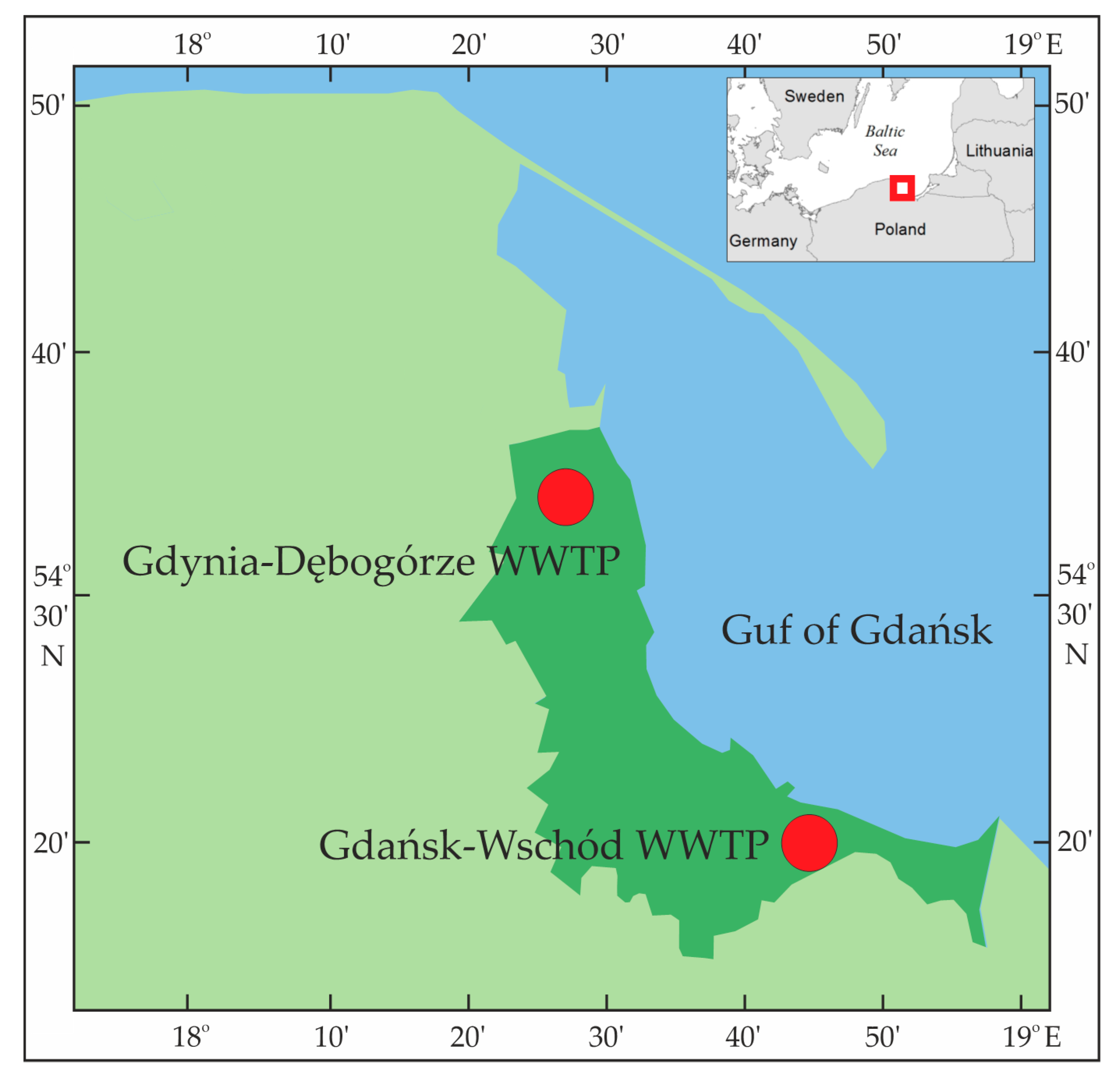

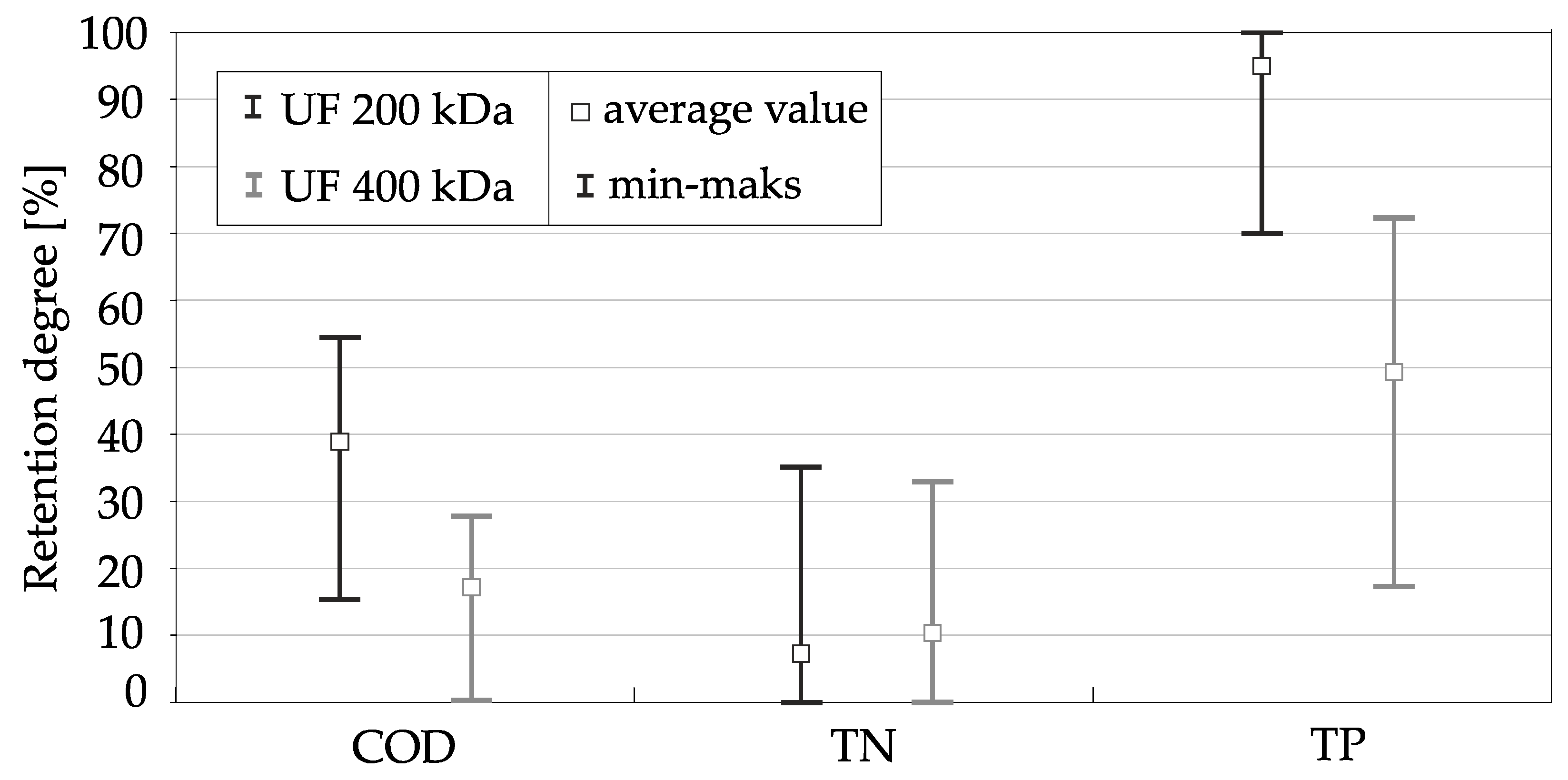
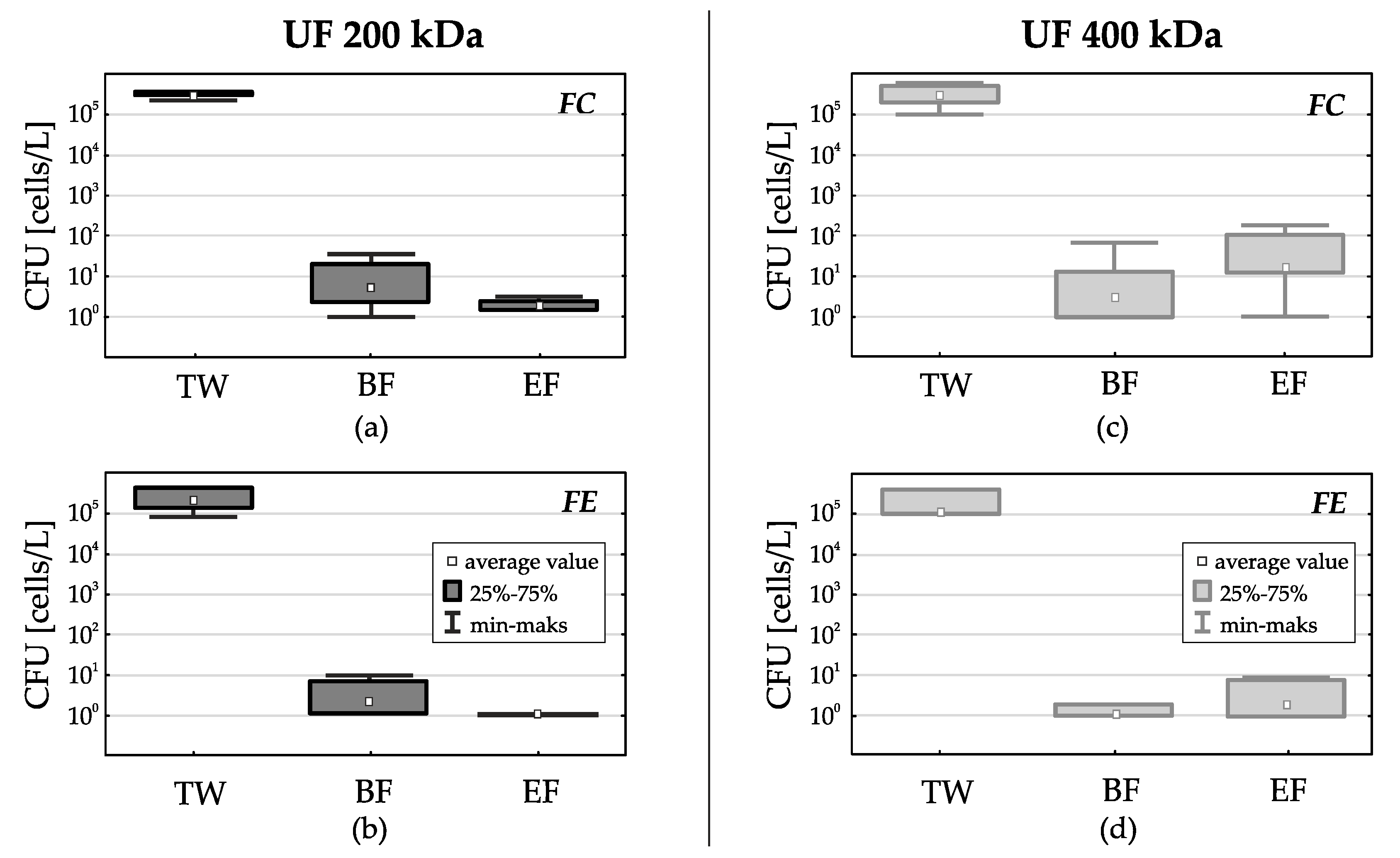
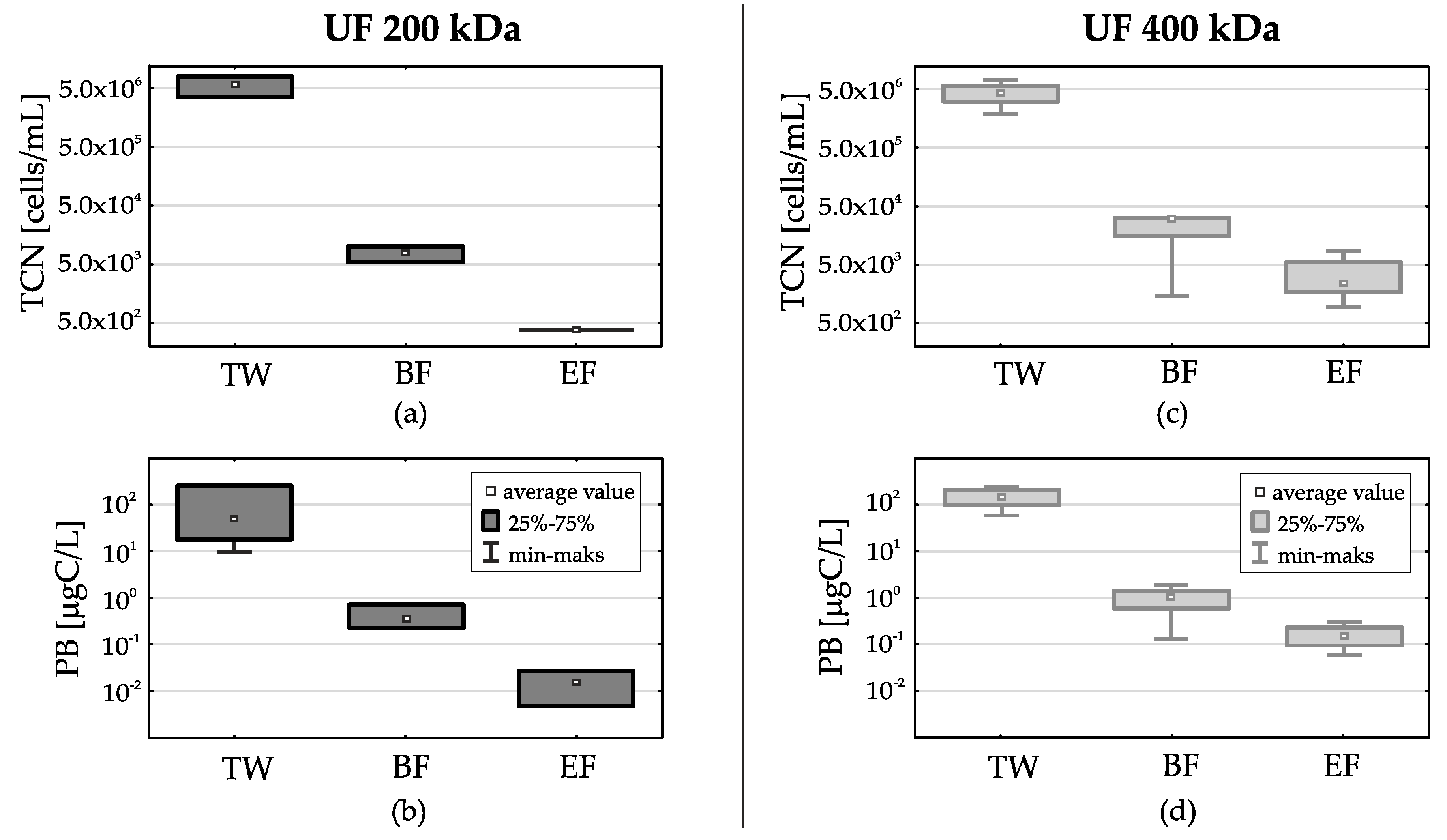
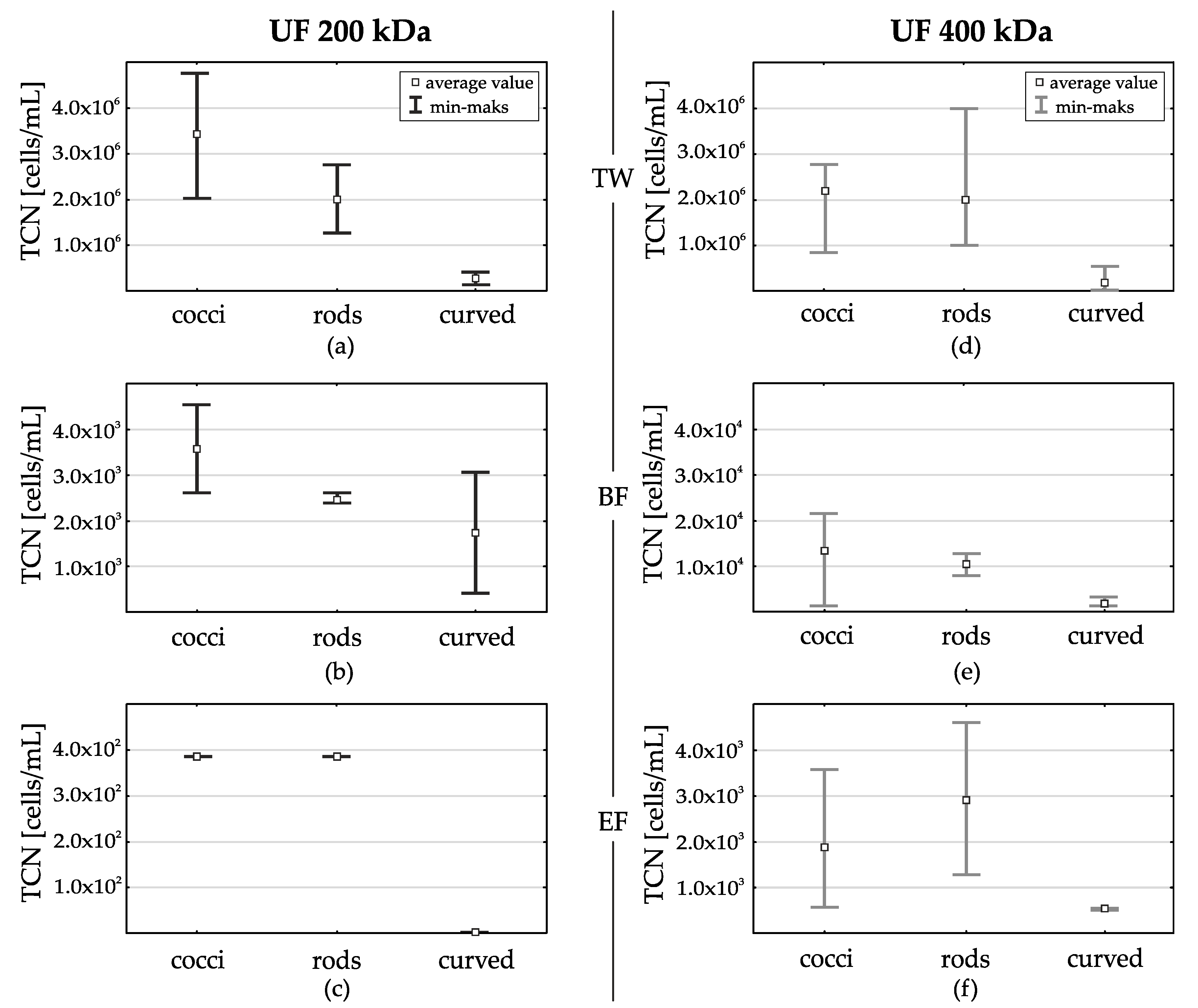
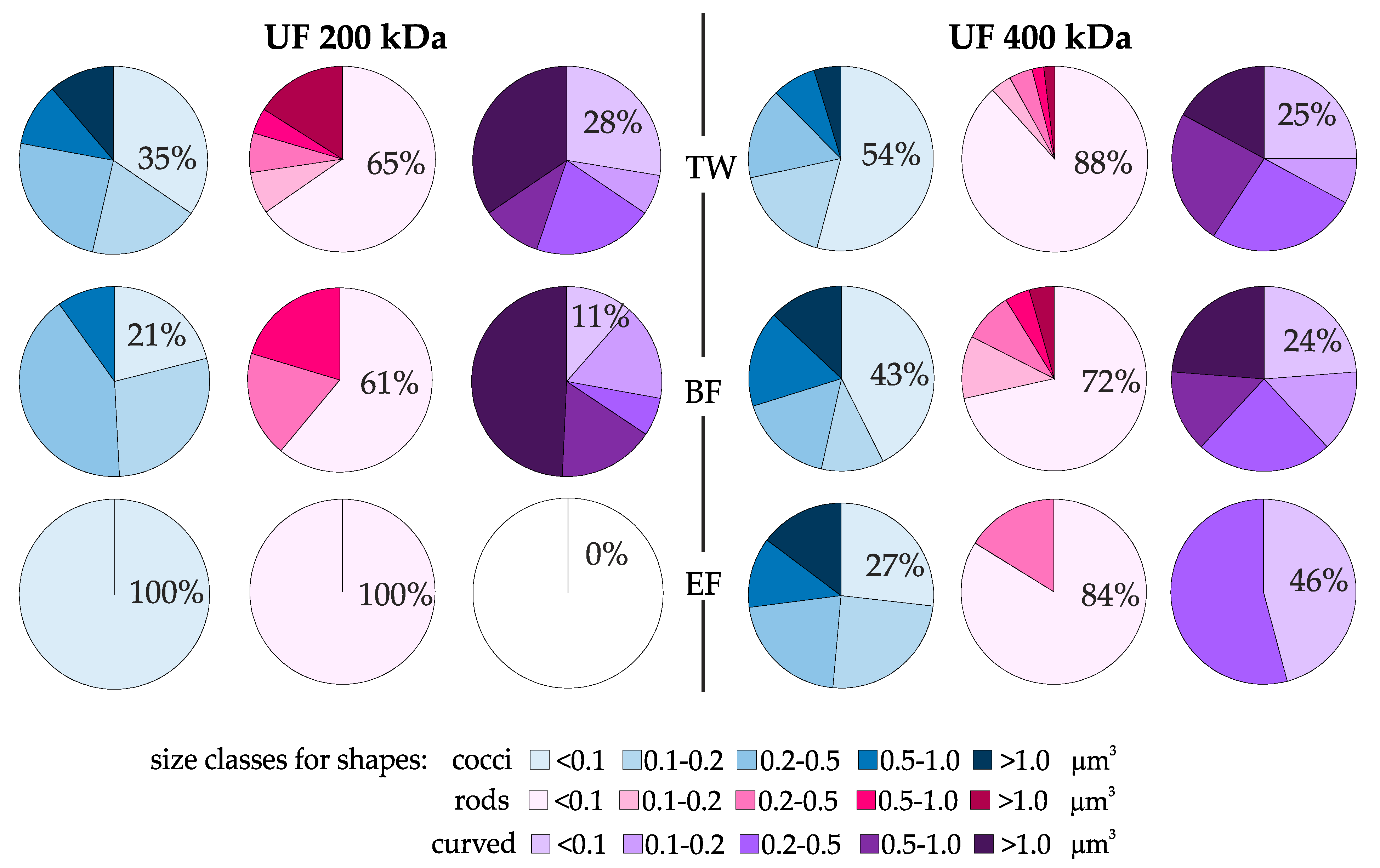
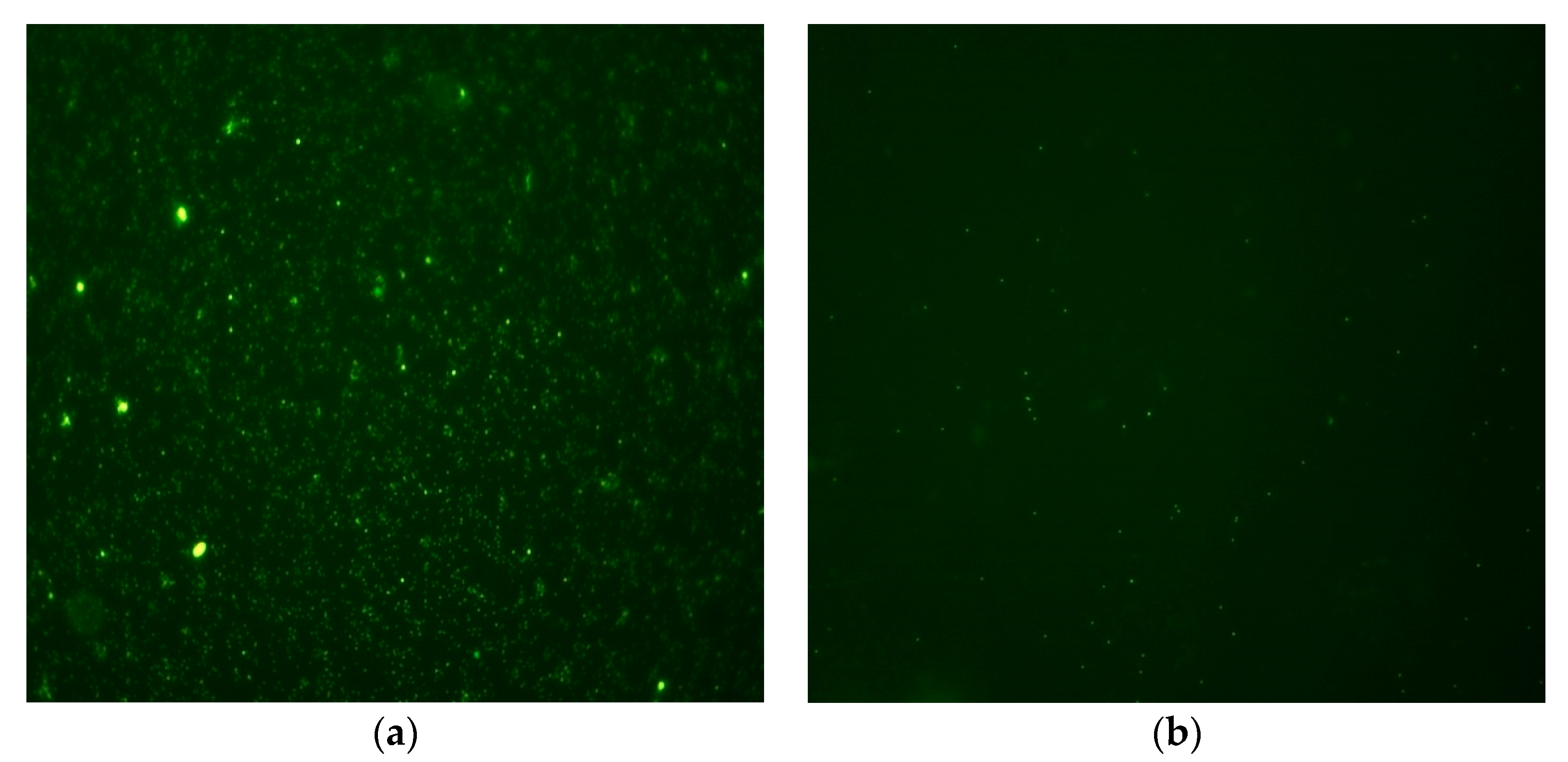
| Turbidity | Chemical Oxygen Demand (COD) | Total Nitrogen (TN) | Total Phosphorus (TP) | |||||
|---|---|---|---|---|---|---|---|---|
| NTU | Retention % | mg O2/L | Retention % | mg/L | Retention % | mg/L | Retention % | |
| Treated wastewater—Gdańsk-Wschód WWTP | ||||||||
| Average | 3.99 | 41.9 | 8.2 | 0.32 | ||||
| Max | 5.35 | 60.0 | 11.5 | 0.44 | ||||
| Min | 1.77 | 33.9 | 5.6 | 0.07 | ||||
| Treated wastewater—the Gdynia-Dębogórze WWTP | ||||||||
| Average | 1.89 | 32.8 | 6.38 | 0.24 | ||||
| Max | 2.20 | 28.2 | 5.51 | 0.21 | ||||
| Min | 1.69 | 40.0 | 7.36 | 0.30 | ||||
| Permeate—membranes with 200 kDa separation | ||||||||
| Average | <0.02 | 99.5 | 25.6 | 37.8 | 7.12 | 8.4 | 0.02 | 94.4 |
| Average at the BF 1 | <0.02 | 99.5 | 25.4 | 37.7 | 7.1 | 10.0 | 0.02 | 95.1 |
| Average at the EF 2 | <0.02 | 99.5 | 25.8 | 38.0 | 7.2 | 6.3 | 0.03 | 93.6 |
| Max | <0.02 | 99.5 | 31.7 | 15.3 | 10.2 | 34.8 | 0.10 | 100 |
| Min | <0.02 | 99.5 | 18.1 | 54.3 | 5.6 | 0.0 | 0.00 | 70.2 |
| Permeate—membranes with 400 kDa separation | ||||||||
| Average | 0.02 | 98.9 | 26.8 | 17.6 | 5.7 | 10.9 | 0.13 | 49.4 |
| Average at the BF 1 | 0.02 | 98.6 | 26.1 | 20.3 | 5.5 | 14.0 | 0.12 | 49.7 |
| Average at the EF 2 | 0.02 | 99.1 | 27.7 | 14.0 | 6.1 | 6.6 | 0.13 | 48.9 |
| Max | 0.09 | 100 | 30.4 | 27.8 | 4.31 | 33.0 | 0.25 | 72.3 |
| Min | 0.00 | 95.2 | 21.7 | 0.0 | 7.44 | 0.0 | 0.07 | 17.2 |
Publisher’s Note: MDPI stays neutral with regard to jurisdictional claims in published maps and institutional affiliations. |
© 2021 by the authors. Licensee MDPI, Basel, Switzerland. This article is an open access article distributed under the terms and conditions of the Creative Commons Attribution (CC BY) license (http://creativecommons.org/licenses/by/4.0/).
Share and Cite
Bray, R.T.; Jankowska, K.; Kulbat, E.; Łuczkiewicz, A.; Sokołowska, A. Ultrafiltration Process in Disinfection and Advanced Treatment of Tertiary Treated Wastewater. Membranes 2021, 11, 221. https://doi.org/10.3390/membranes11030221
Bray RT, Jankowska K, Kulbat E, Łuczkiewicz A, Sokołowska A. Ultrafiltration Process in Disinfection and Advanced Treatment of Tertiary Treated Wastewater. Membranes. 2021; 11(3):221. https://doi.org/10.3390/membranes11030221
Chicago/Turabian StyleBray, Rafał Tytus, Katarzyna Jankowska, Eliza Kulbat, Aneta Łuczkiewicz, and Aleksandra Sokołowska. 2021. "Ultrafiltration Process in Disinfection and Advanced Treatment of Tertiary Treated Wastewater" Membranes 11, no. 3: 221. https://doi.org/10.3390/membranes11030221
APA StyleBray, R. T., Jankowska, K., Kulbat, E., Łuczkiewicz, A., & Sokołowska, A. (2021). Ultrafiltration Process in Disinfection and Advanced Treatment of Tertiary Treated Wastewater. Membranes, 11(3), 221. https://doi.org/10.3390/membranes11030221






